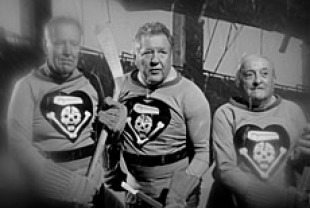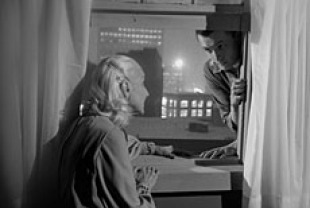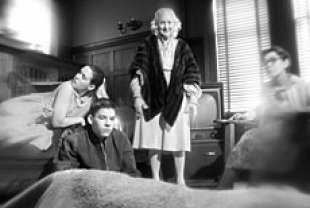Although this creative film is categorized as a documentary, Guy Maddin calls it more accurately a "docu-fantasia" that blends archival footage of the city of Winnipeg with snippets from the filmmaker's childhood and entertaining oddities about the place and the people. Watching it invites us to savor the ideas and emotions connected to our own hometowns. We all have mixed feelings about the place where we grew up; it is likely to arouse within us both nostalgia and the deep need to escape to a more exciting milieu.
That is certainly true for Guy Maddin who has lived in "snowy, sleepwalking Winnipeg" all of his life. As he repeats again and again in the narration, his quest is to leave the coldest city in the world behind but he hasn't been able to do so. "What if I film my way out of here?" he asks, and we begin a journey that mixes memory, history, dreams, and myths. It also brings alive our sense of wonder.
Maddin informs us that Winnipeg has ten times the sleepwalking rate of any city in the world. Perhaps that is related to the cold temperatures or perhaps to the yearning of its people to escape the industrial city with its large railroad yards and unimpressive downtown skyline. Maddin observes that demolition is one of the few growth industries in the place; he laments the destruction of a once thriving department store and the leveling of a sports arena where he spent a lot of his youth watching Winnipeg's NHL hockey team.
The filmmaker turns our attention to the following oddities of the city's history: the 1919 worker's strike, an incident involving some runaway horses encased in river ice, a park composed of garbage where kids on sleds sometimes crash into car fenders protruding from the rubble, the strange city ordinance which requires householders to admit for a night a former owner or resident of their current home, the fascination of citizens for séances and parapsychological happenings, the city's "phantom grid" which consists of a series of nameless back lanes and alleys, and a project which has exiled the city's homeless people to rooftops.
Maddin tries to uncover his inability to escape from Winnipeg by subletting his childhood home for a month and recreating scenes from the past using actors and his mother, actress Ann Savage. This leads him to some personal insights into his character related to his domineering mother, the early death of his father, and a memorable close encounter with a group of Catholic girls in short skirts surrounding him.
Special features on the DVD include new high-definition digital restoration, conversation between director Guy Maddin and art critic Robert Enright, "My Winnipeg" Live in Toronto, a 2008 featurette, various cine-essays by Maddin on Winnipegiana, three Maddin shorts, with introductions by the director: Spanky: To the Pier and Back (2008), Sinclair (2010), and Only Dream Things (2012), deleted scene, PLUS: An essay by critic Wayne Koestenbaum


